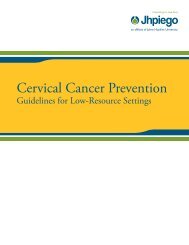Manual for Male Circumcision under Local Anaesthesia
Manual for Male Circumcision under Local Anaesthesia
Manual for Male Circumcision under Local Anaesthesia
Create successful ePaper yourself
Turn your PDF publications into a flip-book with our unique Google optimized e-Paper software.
<strong>Male</strong> circumcision <strong>under</strong> local anaesthesia<br />
Version 3.1 (Dec09)<br />
diluted as recommended by the manufacturer. Other parts of the<br />
clinic, such as the waiting and recovery areas, should be<br />
cleaned regularly with water and detergent.<br />
The lighting in the procedure room should be arranged so that<br />
the penis is well lit, and the surgeon can see what he is doing.<br />
Ideally, the clinic should be equipped with an operating theatre<br />
minor procedures lamp, but these are expensive. Adequate<br />
illumination can be provided by fluorescent lighting over the<br />
operating table.<br />
Emergency medications and equipment <strong>for</strong> managing<br />
anaphylactic reactions 1 should be available in or near the<br />
procedure room. These should be kept in a clearly labelled box,<br />
and the contents should be checked periodically (at least every 6<br />
months) to ensure that they are complete and that none of the<br />
medications are approaching or beyond their expiry date. The<br />
box should be kept in a cool place, away from direct sunlight. In<br />
addition, it is important to have available, in or near the<br />
procedure room, alternative antiseptic surgical cleaning solution,<br />
such as chlorhexidine, <strong>for</strong> patients allergic to povidone iodine,<br />
and spare sutures and needles.<br />
The following equipment and instruments are required <strong>for</strong><br />
standard adult male circumcision: 2<br />
• instrument tray wrapped with sterile drape<br />
• dissecting <strong>for</strong>ceps (finely toothed)<br />
• artery <strong>for</strong>ceps (2 straight, 2 curved)<br />
• curved Metzenbaum’s scissors<br />
• stitch scissors<br />
• Mayo’s needle holder<br />
• sponge-holding <strong>for</strong>ceps<br />
• scalpel knife handle and blades<br />
• “O” drape (80 cm x 80 cm, with ~5 cm hole)<br />
• gallipot <strong>for</strong> antiseptic solution (e.g. povidone iodine)<br />
• povidone iodine (50 ml of 10% solution)<br />
• plain gauze swabs (10 × 10 cm; 10 <strong>for</strong> the procedure, 5 <strong>for</strong><br />
dressing)<br />
• petroleum-jelly-impregnated gauze (5 × 5 cm or 5 × 10 cm)<br />
(tulle gras) and sticking plaster<br />
• 15 ml of 1% plain lidocaine (without epinephrine) anaesthetic<br />
solution<br />
• syringe, 10 ml (if single-use syringes and needles are<br />
unavailable, use equipment suitable <strong>for</strong> steam sterilization)<br />
• injection needles (18- or 21-gauge)<br />
1<br />
2<br />
Emergency medications and equipment:<br />
Essential: pocket mask with one-way valve, atropine (0.6 mg/ml ampoules), epinephrine (1 in<br />
1000 solution (1 mg in 1 ml) ampoules).<br />
Desirable: diazepam suppositories <strong>for</strong> rectal administration (10 mg in 2.5 ml), oxygen supply<br />
with mask and reservoir bag, saline <strong>for</strong> intravenous administration and giving set.<br />
Additional in<strong>for</strong>mation on surgical equipment is available in the WHO Essential Emergency<br />
Equipment List (www.who.int/surgery/imeesc)<br />
Facilities and supplies and preparation <strong>for</strong> surgery Chapter 4-2
















